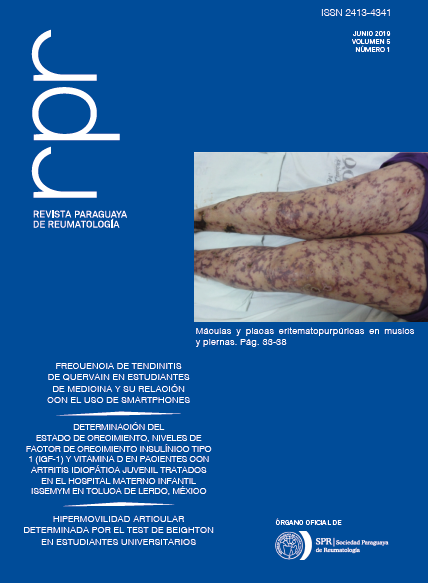Frequency of tendinitis de De Quervain in medical students and its relati onship with the use of smartphones
Abstract
Introduction: De Quervain‘s tenosynovitis is an inflammation of the abductor tendon sheath long and short extensor of the thumb secondary to acute trauma, extreme exercise and accumulated microtraumas due to excessive thumb use, as in the case of the people who send many text messages per day.
Materials and methods: observational, transversal and analytical study. The sample size was 100 medical students from the National University of Asunción, non-probabilistic selection.
Results: Sixty three percent of the students were female. A quarter of responders claimed to send more than 200 messages per day. When performing Finkelstein maneuver, it was found that 39% have De Quervain´s tenosynovitis, 25% corresponding to the female gender. 81% of students who perform text messages result in pain in the hand, followed by 92% and 40%, due to pain in the ipsilateral elbow and shoulder, respectively. In addition, 90% present paresthesias in the hands. No relationship was found between the number of sending text messages and the presence of De Quervain´s tenosynovitis.
Conclusion: Almost 40% of young people who use smartphones have De Quervain´s tenosynovitis, but the greater use of it does not show a greater predisposition, while other associated factors must be studied.
Downloads
References
(1) Ashurst JV, Turco DA, Lieb BE. Tenosynovitis caused by texting: an emerging disease. J Am Osteopath Assoc. 2010 May;110(5):294-6.
(2) Tendon trouble in the hands: de Quervain‘s tenosynovitis and trigger finger. Women are more likely than men to develop these painful conditions. Harv Womens Health Watch. 2010 Apr;17(8):4-5.
(3) Paynter M. Identifying De Quervain‘s tenosynovitis. Emerg Nurse.2006 Apr;14(1):27-9.
(4) Ali M, Asim M, Danish SH, Ahmad F, Iqbal A, Hasan SD. Frequency of De Quervain‘s tenosynovitis and its association with SMS texting.Muscles Ligaments Tendons J. 2014 May 8;4(1):74-8.
(5) Anderson SE, Steinbach LS, De Monaco D, Bonel HM, Hurtienne Y, Voegelin E. “Baby wrist”: MRI of an overuse syndrome in mothers. AJR Am J Roentgenol 2004;182:719 –24.
(6) Sharma R, Aggarwal AN, Bhatt S, Kumar S, Bhargava SK. Outcome of low level lasers versus ultrasonic therapy in de Quervain‘s tenosynovitis.Indian J Orthop. 2015 Sep-Oct;49(5):542-8.
(7) Skef S, Ie K, Sauereisen S, Shelesky G, Haugh A. Treatments for de Quervain Tenosynovitis. Am Fam Physician. 2018;97(12):online.
(8) Ashraf MO, Devadoss VG. Systematic review and meta-analysis on steroid injection therapy for de Quervain‘s tenosynovitis in adults. Eur J Orthop Surg Traumatol. 2014;24(2):149-57.
(9) Vivas S. Patología asociada al uso excesivo de dispositivos móviles en estudiantes entre 18 y 25 años de la Pontificia Universidad Católica de Ecuador [Tesis]. Quito: Repositorio Digital, Pontificia Universidad Católica de Ecuador; 2015. Disponible en: http://bitly/2arrfOg
(10) López DM. Paraguay, Costa Rica, Uruguay y México: los países de Latinoamérica donde más se usan las redes sociales. Abril 28,2017. Disponible en: https://elpais.com/internacional/2016/12/30/actualidad/1483055106_448456.html
(11) PortalTIC/Europapress. Google y Apple se ponen serios con la adicción al 'smartphone‘: aplicaciones nativas para gestionar el uso del móvil. Madrid: Europapress [Internet]. Junio 11, 2018. Disponible en: https://www.europapress.es/portaltic/software/noticia-google-apple-ponen-serios-adiccion-smartphone-aplicacionesnativas-gestionar-uso-movil-20180611085937.html
(12) Ocampos D, Román A, Cristaldo D. SENATICs. Encuesta sobre acceso y uso de Internet en Paraguay. 2017.
(13) Gustafsson E, Johnson PW, Hagberg M. Thumb postures and physical loads during mobile phone use–A comparison of young adults with and without musculoskeletal symptoms. Journal of Electromyography and Kinesiology. 2010;20(1):127-135.
(14) Traverso AM, Douek P, Schivo D, Bruyère C, Müller CT, Krähenbühl SM. De Quervain Tenosynovitis in a 12-Year-Old Child: A Generation’s Disease?. J Orthop Surg Tech. 2017;1(2):29-32.
(15) Akkaya N, Dogu B, Ünlü Z, Çarl AB, Akkaya S, Tekin L, Özçakar L. Ultrasonographic evaluation of the flexor pollicis longus tendon in frequent mobile phone texters. Am J Phys Med Rehabil. 2015;94(6):444-8.
(16) Goel R, Abzug JM. de Quervain‘s tenosynovitis: a review of the rehabilitative options. Hand (N Y). 2015;10(1):1-5.
(17) Aguilera-Manrique G, Márquez-Hernández VV, Alcaraz-Córdoba T, Granados-Gámez G, Gutiérrez-Puertas V, Gutiérrez-Puertas L. The relationship between nomophobia and the distraction associated with smartphone use among nursing students in their clinical practicum. PLoS One. 2018;13(8):e0202953.
(18) De-Sola Gutiérrez J, Rodríguez de Fonseca F, Rubio G. Cell-Phone Addiction: A Review. Front Psychiatry. 2016;7:175.
Copyright (c) 2019 Paraguayan Journal of Rheumatology

This work is licensed under a Creative Commons Attribution 4.0 International License.









